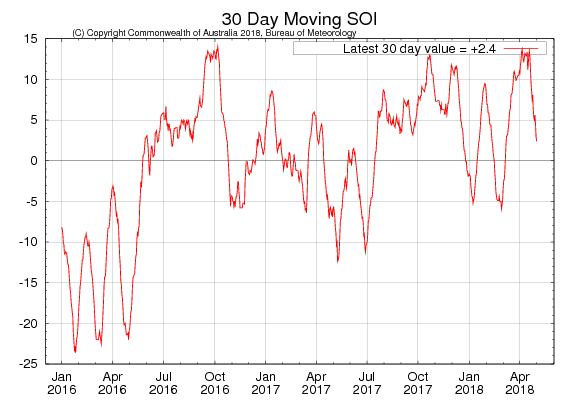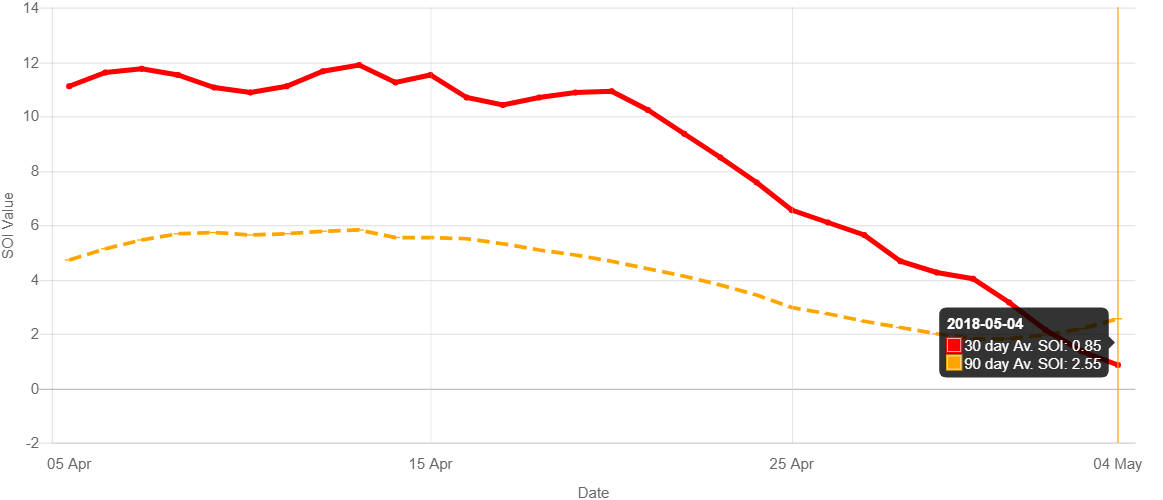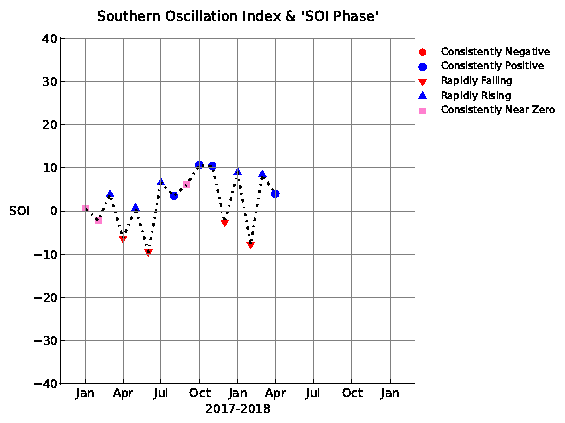ENSO Status on 4th May 2018
Weak La Nina Exists Till The End Of April 2018.
2018 એપ્રિલ આખર સુધી સામાન્ય લા નિના હજુ અસ્તિત્વ માં છે.
The ONI is based on SST departures from average in the Niño 3.4 region, and is a principal measure for monitoring, assessing, and predicting ENSO. Defined as the three-month running-mean SST departures in the Niño 3.4 region. Departures were based on a set of improved homogeneous historical SST analyses (Extended Reconstructed SST – ERSST.v4) and have now been updated to further improved homogeneous historical SST analyses (Extended Reconstructed SST – ERSST.v5). Explanation about ERSST.v5 is given here.
The SST reconstruction methodology is described in Huang et al., 2015, J. Climate, vol. 28, 911-930.
CPC uses current Climatology based on 1986-2015 which has been changed late last year from base years 1981-2010. Explanation about Climatology base years change is given here.
NOAA Operational Definitions for El Niño and La Niña, El Niño: characterized by a positive ONI greater than or equal to +0.5ºC. La Niña: characterized by a negative ONI less than or equal to -0.5ºC. By historical standards, to be classified as a full-fledged El Niño or La Niña episode, these thresholds must be exceeded for a period of at least 5 consecutive overlapping 3-month seasons.
CPC considers El Niño or La Niña conditions to occur when the monthly Niño3.4 OISST departures meet or exceed +/- 0.5ºC along with consistent atmospheric features. These anomalies must also be forecast to persist for 3 consecutive months.
Last five ONI Index are OND 2017 -0.9ºC, NDJ 2018 -1.0ºC, DJF 2018 -0.9ºC, JFM 2018 -0.8ºC and FMA 2018 -0.6ºC. La Nina event was already in existence and since the latest 3-monthly seasonal ONI Index is less than or equal to -0.5ºC it fulfills the NOAA criteria for continuance of La Nina at the end of April 2018.
La Nina event 2017-18 has officially evolved at the end of March 2018 (JFM 2018). This La Nina event is the second consecutive La Nina event, the other being 2016-17 La Nina event that ended at the end of January 2017 (NDJ 2017).
Latest Oceanic Nino Index (ONI) Graph Showing Continuance Of La Nina For FMA 2018 Season
The Table below shows the monthly SST of Nino3.4 Region and the Climate adjusted normal SST and SST anomaly for last two years. Climate Base 1986-2015. ERSST.v5
Period Nino3.4 ClimAdjust YR MON Temp.ºC Temp.ºC ANOM ºC 2016 3 28.90 27.21 1.70 2016 4 28.73 27.73 0.99 2016 5 28.24 27.85 0.39 2016 6 27.70 27.65 0.05 2016 7 26.82 27.26 -0.44 2016 8 26.28 26.91 -0.63 2016 9 26.15 26.80 -0.65 2016 10 25.98 26.75 -0.78 2016 11 25.95 26.75 -0.80 2016 12 26.10 26.65 -0.55 2017 1 26.12 26.45 -0.33 2017 2 26.68 26.66 0.02 2017 3 27.33 27.21 0.12 2017 4 28.04 27.73 0.30 2017 5 28.30 27.85 0.45 2017 6 28.06 27.65 0.41 2017 7 27.54 27.26 0.28 2017 8 26.70 26.91 -0.21 2017 9 26.29 26.80 -0.51 2017 10 26.15 26.75 -0.60 2017 11 25.74 26.75 -1.01 2017 12 25.62 26.65 -1.04 2018 1 25.58 26.45 -0.88 2018 2 25.98 26.66 -0.68 2018 3 26.50 27.21 -0.71 2018 4 27.27 27.73 -0.46
CPC considers El Niño or La Niña conditions to occur when the monthly Niño3.4 OISST departures meet or exceed +/- 0.5°C along with consistent atmospheric features. These anomalies must also be forecast to persist for 3 consecutive months.
Southern Oscillation Index
As per BOM, Australia:
The 30-day Southern Oscillation Index (SOI) to 2nd May 2018 was +2.4, while the 90-day SOI remains within the neutral range.
Sustained positive values of the SOI above +7 typically indicate La Niña while sustained negative values below −7 typically indicate El Niño. Values between about +7 and −7 generally indicate neutral conditions.
Recent (preliminary) Southern Oscillation Index values as per The Long Paddock – Queensland Government.
30 Days average SOI was +4.02 at the end of April 2018 and was +0.85 on 4th May 2018 as per The Long Paddock – Queensland Government and 90 Days average SOI was +2.55.
SOI Monthly graph up to April 2018 as per The Long Paddock – Queensland Government.
Summary by: Climate Prediction Center / NCEP Dated 30th April 2018
ENSO Alert System Status: La Niña Advisory
La Niña conditions are present.*
Equatorial sea surface temperatures (SSTs) are near-to-below average across the east-central and eastern Pacific Ocean.
La Niña is expected to transition to ENSO-neutral during the April-May, with ENSO-neutral then likely (greater than 50% chance) to continue through the Northern Hemisphere summer 2018.
As per BOM -Australia 24th April 2018
ENSO outlooks
All eight of the surveyed international climate models indicate equatorial Pacific sea surface temperatures are likely to rise further over the coming months. A neutral ENSO state is the most likely outcome for the remainder of the southern hemisphere autumn and winter.
Two models indicate central Pacific sea surface temperatures may approach El Niño threshold values during spring, however model outlooks produced during or spanning autumn have a lower accuracy than at other times of the year, and should be viewed with some caution.
(Seasons cited by BOM above are with reference to Southern Hemisphere)
Ashok Patel’s Final Note:
Using NOAA Criteria A Weak La Nina is yet in existence at the end of April 2018 with the latest 3-monthly season FMA 2018 at -0.6ºC
Last five ONI Index are OND 2017 -0.9ºC, NDJ 2018 -1.0ºC, DJF 2018 -0.9ºC, JFM 2018 -0.8ºC and FMA 2018 -0.6ºC. Since, the last consecutive 3-monthly seasonal ONI Index are less than or equal to -0.5ºC it fulfills the NOAA criteria for continuation of a weak La Nina at the end of April 2018.
La Nina event 2017-18 has officially evolved at the end of March 2018 (JFM 2018) and yet is in existence at the end of April 2018. This La Nina event is the second consecutive La Nina, the other being 2016-17 La Nina event that ended at the end of January 2017 (NDJ 2017).
Theoretically a Full Fledged El Nino event is not possible to be established during the Indian Summer Monsoon, since there are only five 3-monthly seasons left till end of September 2018, namely MAM 2018, AMJ 2018, MJJ 2018, JJA 2018 & JAS 2018, and Indian Summer Monsoon normally comes to an end by then (September end).
અશોક પટેલ ની નોંધ :
NOAA માપદંડ મુજબ 2018 એપ્રિલ આખર ના સામાન્ય ‘લા નિના’ હજુ અસ્તિત્વ માં છે.
છેલ્લા પાંચ ત્રી-માસિક સીઝન નું ONI ઈન્ડેક્સ OND 2017 at -0.9°C, NDJ 2018 at -1.0°C, DJF 2018 at -0.9°C, JFM 2018 at -0.8°C, and FMA 2018 at -0.6°C. છેલ્લું ત્રી-માસિક સીઝન નું ONI ઈન્ડેક્સ -0.5°C અથવા તેનાથી નીચે રહેલ છે. એટલે NOAA માપદંડ મુજબ 2018 એપ્રિલ આખર ના સામાન્ય ‘લા નિના’ હજુ અસ્તિત્વ માં છે.
સૈદ્ધાંતિક રીતે ભારતીય ચોમાસા દરમિયાન NOAA ના માપદંડ મુજબ વિધિવત ‘એલ નિનો’ થવાની શક્યતા નથી કારણ કે ભારત નું ચોમાસુ સપ્ટેમ્બર આખરે પૂરું થતું હોય છે અને હવે સપ્ટેમ્બર આખર સુધી ફક્ત પાંચ ત્રી-માસિક સીઝન બાકી છે, જે છે MAM 2018, AMJ 2018, MJJ 2018, JJA 2018 & JAS 2018.
All earlier updates are listed below:
Click here for Update “Full Fledged La Nina Event Has Developed At The End Of March 2018”
Click here for Update “La Nina Event 2017-18 Expected To Commence At The End Of March”
Click here for Update “Three Consecutive 3-Monthly Seasons Have Oni -0.5ºC Or Below”
Click here for Update “ENSO Neutral Conditions Prevails”
Click here for Update “ENSO Neutral Conditions Prevails With JAS 2017 ONI Index At -0.2ºC”
Click here for Update “Theoretically El Nino Not Possible During 2017”
Click here for Update “Theoretically El Nino Not Possible During The Indian Southwest Monsoon 2017”





Sir,mari comment kem aavti nathi
Update vancho
સર વરસાદ જૂન પેલા સે
Sir hve next update kyre krso ane chomasa mate kai agahi krvana ho to e pn jnavjo plz sir…
Hu laamba gaadaa ni aagahi nathi karto.
sir navi update kyare mukaso????
sri garami khubaj vadhu che kutch ma ane haju ketla time garmi rahese sri and tamari new updet kyare karso
સર,
ઘારીયા વાદળો વરસતા નથી
એની પાછળનું કારણ?
yogya paribad na hoy etle.
Equator ni ek baju clockwise ghumri mare ane biji baju anticlockwise..Aavu kem?
Pavano saam saamaa hoy etle banne godardh ma.
શુભ સવાર સાહેબ
ગઈ કાલે જે ઉત્તરાખંડ હિમાચલ રાજસ્થાન અને દિલ્હી માં જે થયું એને સુ કેવાય પ્રિમોન્સૂન અકટીવીટી કે કમોસમી વરસાદ
અને
અજુ બીજા 21રાજ્યોમાં 48 કલાકની આવા વરસાદ ને આંધી ની આગાહી છે એમાં આપડા ગુજરાતમા કોઈ આવી સંભાવના ખરી
21 rajyo tamo kaho chho… naam pan vanchi liyo.
Kamosmi samjo
Sir koi thundercloud thayu hoy Ane varasad padto hoy to tenathi Kai disama nava vadal bane Ane varasad Pragati karse te Kai rite khabar pade
RADAR ma khyal avey…. baaki Satellite Image joya rakho etle khabar padey.
Sir aa radar mate ni link aapo NE
http://www.imd.gov.in/pages/radar_main.php
Sir Prashant mahasagar purv mahasagar aa bane mathi sistam bane to Gujarat ne vadhu varsad Kai mahasagar ni sistam faida kark Hoy
Purva mahasagar etle shu ?
Gotey chadya chho.
India maate Bengal ni Khadi aney Arabian Sea kam kare. Banney baju ni System faydakarak hoy.
Sir it seems that this year monsoon is early
How do you deduce ?
Climate change with irregular symptoms..
Nothing new or abnormal
Sir koi disama vijali thati hoy to te aapana taraf aavase ke Kem te Kai rite nkki karavu?
Evi khbar na padey. Baaki vijadi thay aney aavaj 15 second ma sambhaday etle samajvu ke aa vijadi 5 km dooor chhe.
Avu hoy etle aasharo levo. pan koi jan ke electric thabhala paasey nahi.
Sir the same thing I had listened on man Vs wild show on discovery channel about lightning. Brear Grils show exactly calculations of lightning on that show which you have described in comment.
Sir premonsoon activity kyarathi saru thay chhe?
Andaman Nicobar ma Chomasu bese pachhi.
Sir WD ne karne north west ma thunderstorm activities Thai .. Aa WD ne bhej kyathi male che kya pawano bhej puro pade???
Mediteranean Sea thi Iran, Afghanistan, Pakistan & India
Ha sir, MSLP pan dhime dhime nichu jay rahyu chhe.
COLA week 1&2 mujab south india ma pre-monsoon activity sharu thavana sanket chhe.ke hju vaar chhe?
15 May aaspass toe Andaman baju Monsoon pahonchtu hoy chhe.
Sir aa solae strom vishe janavso?
News batave che ke enathi earth par asar thase.
Evu khas kai nathi… Samanya babat chhe.
Bahu interest hoy jovo http://www.solarham.net/
When monsoon start in lower sindh
Refer to http://www.gujaratweather.com/wordpress/?page_id=14488
Sir,
When will rain start in North Gujarat ??
I want to know Approx date.
refer to http://www.gujaratweather.com/wordpress/?page_id=14488
Sir monsoon mate na kya factors consider karavama aave 6?
http://www.imd.gov.in/pages/monsoon_main.php?adta=PDF&adtb=2
vancho
હાઈ સર
ઘણા બધા રાજ્યોમાં 7 ને 8 તારીખે વાવાઝોડા સાથે કરા પણ પડશે એવી આગાહી છે
આપડા ગુજરાત મા કોઈ સ્થળે આવી સંભાવના ખરી
Thoda divas pahela 100 loko na mrutyu thaya hata achanak pavan vijadi vigere ma. Koi ne jawabdari na levi hoy etle vadhu padti chavcheti maate aagahi.
Aava achanak pavan vari sthiti bahu zadapi taiyar thati hoy chhe. Tena anusandhane varsad/thunder Radar ma khyal aavey pan thoda kalak pahela.
(Sarkari sutro kahe teni amalvari karvi)
સર સુરેન્દ્રનગર કેમ બધાય જિલ્લા કરતા
ગરમ હોય છે એનું કય ખાસ કારણ
Saurashtra karta Gujarat garam rahetu haoy chhe aney Surendranagar Saurashtra/Gujarat nu dwar chhe.
Te kyare bne?
Jyare avey tyare !
Sir rajasthanma aavel bawandar su chhe?
Bawandar etle aandhi… dul ni damrio
Sir mme extended renge atle su
dynamic models including the Multi-model Ensemble (MME) generated by India. Meteorological Department (IMD) of southwest monsoon.
vividdh model nu mixture
E etle extended range
Jsk Sir. Thanks for new update , ane sir La nina sivay na bija je paribado chomasha mate upyogi che teni mahiti thodik vigatvar samjavo to amo ne janva male ke kya kya paribado chomasha mate upy0gi che ??
http://www.imd.gov.in/pages/monsoon_main.php?adta=PDF&adtb=2 vancho
Sir prachim mahasagar nu temprechr uchu she ke nichu janavcho sir pls
Pashchim Prashant mahasagar nu taapmaan normal najik chhe
Good information sir
તો આનાથી વરસાદ મા કોઈ અસર થાય ખરી?
La Nina ke El Nino ek paribad chhe. CHomasa maate 6 thi 8 paribad kaam kare te paike nu ek chhe.
It may be good news for Indian Monsoon season….
પરફેક્ટ mahiti thx sirji
LA nina kaya shudhi rahese?
Dar mahine update ma khyaal avey.
Post comment about La Nina & EL Nino. Other comments to be posted on weather forecast page.
La Nina and El Nino બાબત ની કમેન્ટ કરવી. બાકી બધી કમેન્ટ આગાહી ના પેજ પર કરવી